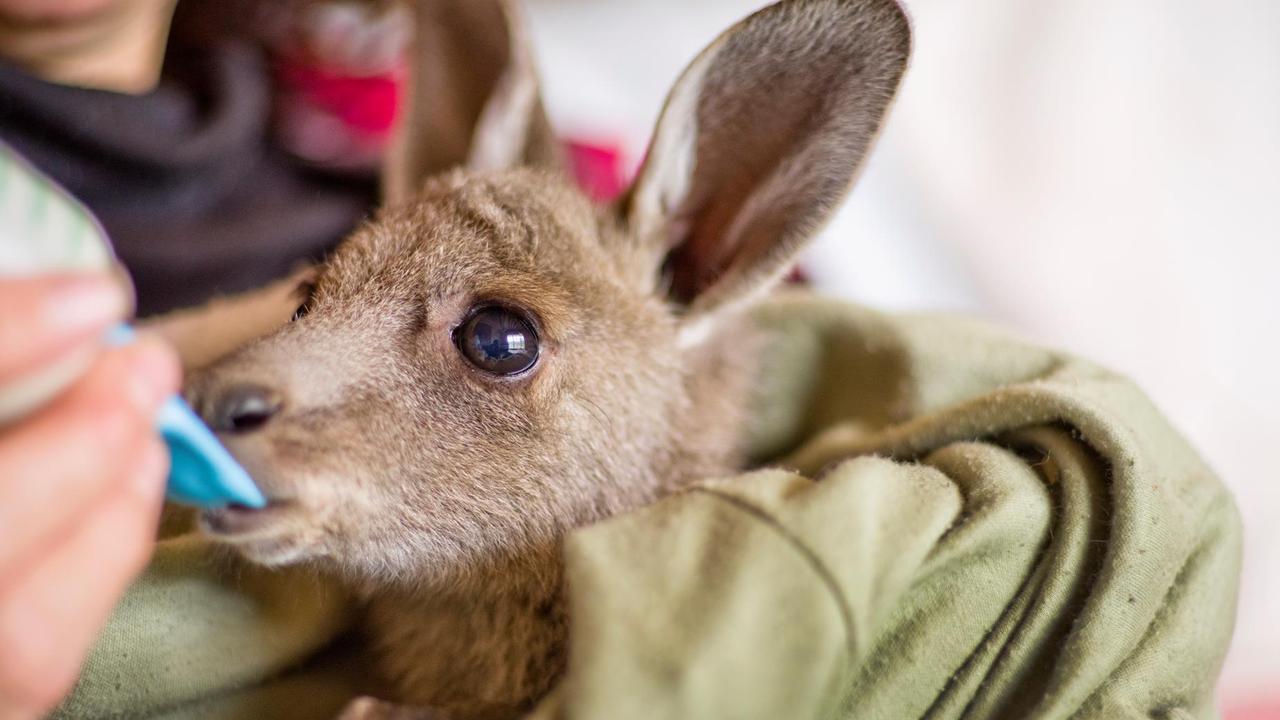Australian Farming Families book extract by Deb Hunt: A mother’s love conquers all
WHEN Cath Marriott’s husband died, the farmer raised their four children through flood, fire, drought and debt.

VIC News
Don't miss out on the headlines from VIC News. Followed categories will be added to My News.
When Cath Marriott’s husband died of stomach cancer, the Benalla farmer raised their four children — Catherine, 9, Hannah, 8, Charlie, 7, and the youngest, Tom, who had
just turned five — through flood, fire, drought and debt. Author DEB HUNT picks up Cath’s story just after Cath and John had finished building their home.
----
THE house went up quickly, fuelled by the energy and enthusiasm of the whole family, and it was only when they’d finished the last coat of paint that John put down his brush and said: “I feel a bit crook.”
The diagnosis shocked them all: stomach cancer.
John was a slim, fit man who didn’t smoke, didn’t drink and didn’t use chemicals. He grew all his own organic vegetables and he avoided salted meat .
The only possible causal link Cath could find was the switch from tank water to bore water while the house was being built.
“The bore water had a high level of sodium nitrite, that’s the only thing we think might have triggered it.”
With a growing family and a flourishing farm, John had everything to live for. Sadly, after three lots of punishing chemotherapy, the discovery of inoperable seeding in his peritoneal cavity stopped any further medical intervention.
“I would rather die than put any more of that poison into my system,” he said.
“John did his absolute best to survive to see his children grow up,” Cath said.
Having dreamt of seeing the children reach adulthood, John lowered his expectations. He fought to make it to his 40th birthday, sustained by good food, homegrown vegies and daily meditation.
On the days that John struggled, Cath was there for him, reminding him that unless he had bad days he wouldn’t know what good days were. It was about choosing to focus on the positive, Cath said.
As the disease took hold, Cath inevitably became more involved in the running of the farm.
“There were many things John could no longer do, but he didn’t let that loss define him. He still
had his family around him and he was the father of that family. He was determined to live with peace and joy, in the full knowledge that he had cancer.”
Defying the medical profession that only gave him six months, John Marriott lived a life of quality for a further 15 months.
He died in March 1990, six months after his 40th birthday and exactly five years to the day since he and Cath had bought Yarallah, their property at Benalla. Cath was with him until the end, quietly holding his hand as he passed.
Suddenly Cath was a single parent and a farmer, torn between the needs of the children and the demands of the farm. Much of her energy and ingenuity had to go into parenting, and her own grief at losing the soulmate she’d never expected to find had to be set aside as she focused on raising the children and running the farm.
Drawing on resources she didn’t know she had, Cath navigated her way through that dark period. However, maintaining discipline with four young children under the age of 10 required considerable ingenuity. Cath was once so exasperated by their behaviour in the local supermarket that she turned the tables on them.
“I parked the trolley in the middle of an aisle, lay down on the floor and threw a full-on tantrum.”
Her drumming heels and loud voice so alarmed the children (and no doubt other shoppers) that they never misbehaved in the supermarket again.
It sounded like Cath’s parenting was far more successful than she gave herself credit for, then she told me a story that made me wonder.
Shortly after John’s death, her daughter Catherine appeared in the kitchen one afternoon with her younger brothers and sisters. They were carrying suitcases that Catherine had packed for them.
The determined young girl stood in front of her mother with the younger children lined up behind, all of them clutching their cases.
“We’re leaving home,” Catherine said, gravely.
“Why?” Cath asked.
“We don’t think you’re a suitable mother.”
And Catherine led her siblings across the yard to an old weatherboard cottage they used as an office.
“We never got to the point of working out what the unsuitable thing was.”
Cath was laughing but I couldn’t help thinking that after the loss she’d endured and the strict upbringing she’d had, such blunt criticism from her own child must have been painful.
The many challenges of running a farm and raising four children as a single parent were exacerbated three years later when Benalla suffered the worst floods in living memory.
IT was a Sunday, October 3, 1993, and heavy rain had fallen all day. The steady, continuous downpour had drenched paddocks at Yarallah and run off into the creek, which quickly broke its banks and flooded low-lying areas. The Baddaginnie Goomalibee Road was soon underwater, although that wasn’t unusual — it had happened before and once the rain stopped any floodwater would usually subside quite quickly. That night the rain kept falling.
Streets in the nearby town of Benalla were soon awash and residents went to bed listening to the sound of rain drumming on their roofs. From 7am Sunday to 9am Monday, 165mm of rain fell on Benalla — about one third of the town’s annual total rainfall. Residents woke to find the town submerged.
According to Cath, emergency services could have sounded the alarm but chose not to, fearing people might have panicked in the middle of the night. As a result, some people stepped out of bed and found themselves knee-deep in water.
There was no danger the hilltop house at Yarallah would flood but Cath was deeply concerned about her sheep. Some of the ewes were lambing on the home farm and she had a flock of 1200 hoggets (young sheep just beyond lambs) on an irrigation block 20km away that John had purchased before he died. The block, on the edge of the Broken River, had flooded with water rising from Cowan’s floodway and spreading across the entire farm.
Cath and the children got up at dawn and drove out to the block, accompanied by Howard, the
farm manager. In the pre-dawn light they could see sheep struggling to move through the
rising floodwater.
Cath dropped Howard, Catherine, Charlie and Hannah on the eastern side of the farm. “Get the hoggets to move towards the green. Lead them towards high acre,” she urged. The acre she was referring to had been fenced off since the early days of settlement and had never flooded. Cath knew that if they could just get the sheep there they’d be safe.
“Push them towards higher ground,” she shouted. “I’ll take Tom and come in from the Midland Highway.”
The farm manager plunged through the floodwater, cutting fence lines to give the exhausted animals a better chance of swimming in the same direction as the water flow, and 12-year-old Catherine splashed through water up to her knees beside him. Farm dogs jumped along with her.
Cath and Tom approached the flood from another direction.
Eight-year-old Tom had already lost his footing in a culvert and he was soaked before they even reached the main body of water.
“Mum, the lambs over here won’t swim,” Catherine shouted, fighting back tears as she tried to push the terrified creatures through water that was now waist-deep. “They won’t swim!”
Cath could see the young sheep were exhausted and she knew they wouldn’t survive.
“Sweetheart, they’re not going to make it,” she said, as gently but as firmly as she could. “You have to leave them. You have to concentrate on the stronger ones, we might be able to save them.”
The floodwaters were rising so fast the “green” was disappearing in front of their eyes. Further west, the acre they were heading for turned out to be knee-deep in water as well.
“The silage mound!” Cath shouted, spotting a glimmer of hope.
“Head for the silage mound!”
Agricultural students from Dookie College drove out to see if they could help and their arrival lifted everyone’s spirits. The students joined the rescue effort with renewed shouts as they drove the sheep on, pushing them towards the only clear piece of ground for miles around. Cath couldn’t remember how long they worked. Time wasn’t measured in hours, it was measured in lives saved — around 200 on that exhausting day.

At the end of the rescue effort their neighbour Jeannette took the children for a hot bath and Cath summoned the last of her energy to push through chest-high water with Howard and reach two sheep dogs that had survived by swimming through the water then lodging themselves in the branches of some of the trees that Cath and the children had planted.
It took four days for the floodwaters to subside and when they did the full extent of the tragedy was revealed. They lost almost 1200 sheep, 1000 of them hoggets at the river block and the remainder old ewes and new lambs from Yarallah. Clearing up the carcasses was an arduous, distressing job, shared by many.
Well-meaning people suggested Cath send her children to counselling to help them get over the trauma of what had happened but Cath scoffed at the idea. She had no intention of sending the children to a shrink.
“Life is full of joy, just as it is full of the potential for things out of our control to go horribly wrong,” she told her well-meaning friends.
I disagreed with Cath’s dismissal of counselling yet who was I to judge? She and her children had seen first-hand how life could unexpectedly dish out the harshest blows and they had also seen how it could deliver the strongest love.
The 1993 flood was just one example of how the family stood together in times of crisis.
An edited extract from Australian Farming Families, by Deb Hunt, Macmillan Australia, rrp $30
Originally published as Australian Farming Families book extract by Deb Hunt: A mother’s love conquers all


